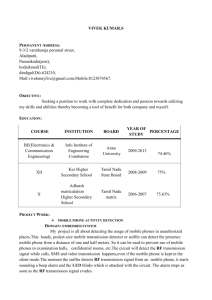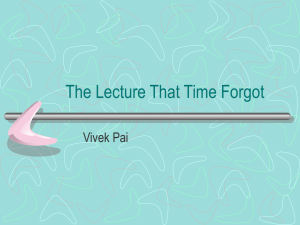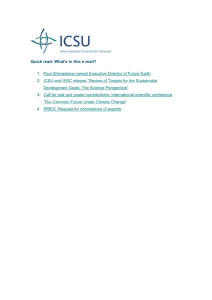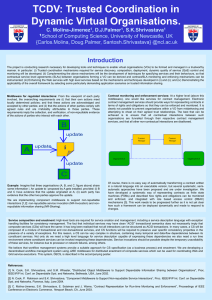CENTAUR: Realizing the Full Potential of Centralized WLANs Through a Hybrid
advertisement
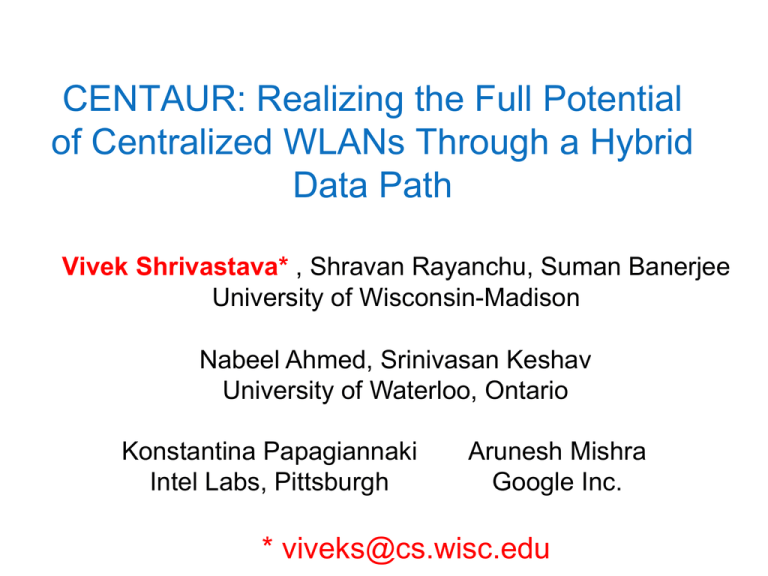
CENTAUR: Realizing the Full Potential
of Centralized WLANs Through a Hybrid
Data Path
Vivek Shrivastava* , Shravan Rayanchu, Suman Banerjee
University of Wisconsin-Madison
Nabeel Ahmed, Srinivasan Keshav
University of Waterloo, Ontario
Konstantina Papagiannaki
Intel Labs, Pittsburgh
Arunesh Mishra
Google Inc.
* viveks@cs.wisc.edu
Centralization of Enterprise WLANs
Clients
Internet
Access
Point
Wireless controller
Vivek Shrivastava
2
2
Centralization of Enterprise WLANs
Common control plane functions
Power control
Channel assignment
Vivek Shrivastava
3
3
Centralization of Enterprise WLANs
What about data plane functions?
Power control
Channel assignment
Data scheduling ?
Vivek Shrivastava
4
4
Can centralized scheduling help?
Vivek Shrivastava
5
5
Can centralized scheduling help?
Hidden terminals
Vivek Shrivastava
6
6
Can centralized scheduling help?
Hidden terminals
Vivek Shrivastava
7
7
Can centralized scheduling help?
Hidden terminals
Vivek Shrivastava
8
8
Can centralized scheduling help?
Hidden terminals
1. Carrier sense
Vivek Shrivastava
9
9
Can centralized scheduling help?
Hidden terminals
2. Channel free,
transmit
Vivek Shrivastava
10
10
Can centralized scheduling help?
• Collision!
• Backoffs
• Low throughputs
3. Collision !
Vivek Shrivastava
11
11
How bad is it ?
Experiments on production
building-wide WLANs
•W1: 5 floors
9 APs, 45 clients
• W2: 1 floor
21 APs, 51 clients
10% links suffer more
than 70% throughput
reduction
Vivek Shrivastava
12
12
A lost opportunity ?
Suppose infrastructure
can gather conflict data
Vivek Shrivastava
13
13
A lost opportunity ?
And when packets arrive
…
Vivek Shrivastava
14
14
A lost opportunity ?
… realize interference
will happen …
Vivek Shrivastava
15
15
A lost opportunity ?
1. Transmit first packet
Vivek Shrivastava
16
16
A lost opportunity ?
1. Transmit first packet
2. Transmit second packet
with delay
Vivek Shrivastava
17
17
Use an in-band scheduler
Simple FIFO schedule
with interference
avoidance
Scheduling
functionality
Vivek Shrivastava
18
18
What about exposed terminals ?
• In our experiments, about 41%of link pairs suffer
from exposed terminal interference
• Disabling carrier sense to solve the problem can be
dangerous for uplink, non-enterprise traffic
• We will show how centralization can help even here
Vivek Shrivastava
19
19
Challenge
• Centralization has obvious overheads
• How to make this feasible and useful under
• Real applications
• Common large-scale wireless environments
• Presence of uplink and non-enterprise traffic
• Requirements of no client modifications
Vivek Shrivastava
20
20
Contributions
1.Design CENTAUR, a hybrid (partly centralized,
partly distributed) scheduling approach
• Resolves hidden and exposed terminals
• Requires no client modifications
• Requires no carrier sense disabling
2.Evaluate CENTAUR on two WLAN testbeds with
real-world traffic traces
• 1.48x greater throughput for bulk data traffic
• 1.38x reduction in web-transaction times
Vivek Shrivastava
21
21
Outline
•
A naïve attempt at centralized scheduling
(DET)
• Our hybrid centralized scheduler
(CENTAUR)
• Evaluation
• Related Work
• Summary
Vivek Shrivastava
22
22
Outline
•
A naïve attempt at centralized scheduling
(DET)
• Our hybrid centralized scheduler
(CENTAUR)
• Evaluation
• Related Work
• Summary
Vivek Shrivastava
23
23
DET: A Simple Deterministic Scheduler
Vivek Shrivastava
24
24
DET: A Simple Deterministic Scheduler
Input:
Conflict graph
Vivek Shrivastava
25
25
DET: A Simple Deterministic Scheduler
Goal:
Schedule each incoming downlink packet
Input:
Conflict graph
Vivek Shrivastava
26
26
DET: A Simple Deterministic Scheduler
Goal:
Schedule each incoming downlink packet
Input:
Conflict graph
Transmission
1 2 3slots
4
Vivek Shrivastava
27
27
DET: A Simple Deterministic Scheduler
1. New packet arrives
Transmission
1 2 3slots
4
Vivek Shrivastava
28
28
DET: A Simple Deterministic Scheduler
1. New packet arrives
2. Find the earliest conflict
free slot
Transmission
1 2 3slots
4
Vivek Shrivastava
29
29
DET: A Simple Deterministic Scheduler
1. New packet arrives
2. Find the earliest conflict
free slot
Transmission
1 2 3slots
4
Vivek Shrivastava
30
30
DET: A Simple Deterministic Scheduler
1. New packet arrives
2. Find the earliest conflict
free slot
3. Schedule the packet in that
slot
Transmission
1 2 3slots
4 5
Vivek Shrivastava
31
31
Performance of DET
No gains for exposed terminals; Non4xperform worse under load
conflicting links
Vivek Shrivastava
32
Outline
•
A naïve attempt at centralized scheduling
(DET)
• Our hybrid centralized scheduler
(CENTAUR)
• Evaluation
• Related Work
• Summary
Vivek Shrivastava
33
33
Overview of CENTAUR
• Incorporate basic DET scheduler
• Tackle DET’s shortcomings:
•
Amortize scheduling overhead
• Improve performance for exposed links
•
Avoid degrading normal links
• Coexist with non-enterprise and uplink traffic
Vivek Shrivastava
34
34
(1) Avoid Scheduling Overheads
•
Problem: Per-packet scheduling performs
poorly under high network loads
•
Solution:
•
Vivek Shrivastava
Schedule packets in batches (or epochs)
35
35
(1) Avoid Scheduling Overheads
•
Problem: Per-packet scheduling performs
poorly under high network loads
•
Solution:
•
Vivek Shrivastava
Schedule packets in batches (or epochs)
36
36
(1) Avoid Scheduling Overheads
•
Problem: Per-packet scheduling performs
poorly under high network loads
•
Solution:
•
Schedule packets in batches (or epochs)
Wired ack
Vivek Shrivastava
37
37
(1) Avoid Scheduling Overheads
•
Problem: Per-packet scheduling performs
poorly under high network loads
•
Solution:
•
Vivek Shrivastava
Schedule packets in batches (or epochs)
38
38
(1) Avoid Scheduling Overheads
•
Problem: Per-packet scheduling performs
poorly under high network loads
•
Solution:
•
Vivek Shrivastava
Schedule packets in batches (or epochs)
39
39
(1) Avoid Scheduling Overheads
•
Problem: Per-packet scheduling performs
poorly under high network loads
•
Solution:
•
Vivek Shrivastava
Schedule packets in batches (or epochs)
40
40
(1) Avoid Scheduling Overheads
•
Problem: Per-packet scheduling performs
poorly under high network loads
•
Solution:
•
Vivek Shrivastava
Schedule packets in batches (or epochs)
41
41
(1) Avoid Scheduling Overheads
•
Problem: Per-packet scheduling performs
poorly under high network loads
•
Solution:
•
Schedule packets in batches (or epochs)
Wired ack
Vivek Shrivastava
42
42
(1) Avoid Scheduling Overheads
•
Problem: Per-packet scheduling performs
poorly under high network loads
•
Solution:
•
Vivek Shrivastava
Schedule packets in batches (or epochs)
43
43
(2) Improve Exposed Terminals
•
Problem: Exposed links can operate in parallel
but don’t due to carrier-sensing
•
Solution:
•
Schedule batch of packets, fix backoff
periods
Vivek Shrivastava
44
44
(2) Improve Exposed Terminals
•
Problem: Exposed links can operate in parallel
but don’t due to carrier-sensing
•
Solution:
•
Vivek Shrivastava
Schedule batch of packets, fix backoff
periods
45
45
(2) Improve Exposed Terminals
•
Problem: Exposed links can operate in parallel
but don’t due to carrier-sensing
•
Solution:
•
Schedule batch of packets, fix backoff
periods
Variable wired delay
Vivek Shrivastava
46
46
(2) Improve Exposed Terminals
•
Problem: Exposed links can operate in parallel
but don’t due to carrier-sensing
•
Solution:
•
Vivek Shrivastava
Schedule batch of packets, fix backoff
periods
47
47
(2) Improve Exposed Terminals
•
Problem: Exposed links can operate in parallel
but don’t due to carrier-sensing
•
Solution:
•
Schedule batch of packets, fix backoff
periods
Carrier sense,
deferral
Vivek Shrivastava
48
48
(2) Improve Exposed Terminals
•
Problem: Exposed links can operate in parallel
but don’t due to carrier-sensing
•
Solution:
•
Vivek Shrivastava
Schedule batch of packets, fix backoff
periods
49
49
(2) Improve Exposed Terminals
•
Problem: Exposed links can operate in parallel
but don’t due to carrier-sensing
•
Solution:
•
Vivek Shrivastava
Schedule batch of packets, fix backoff
periods
50
50
(2) Improve Exposed Terminals
•
Problem: Exposed links can operate in parallel
but don’t due to carrier-sensing
•
Solution:
•
Schedule batch of packets, fix backoff
periods
Schedule packets in
batches
Vivek Shrivastava
51
51
(2) Improve Exposed Terminals
•
Problem: Exposed links can operate in parallel
but don’t due to carrier-sensing
•
Solution:
•
Vivek Shrivastava
Schedule batch of packets, fix backoff
periods
52
52
(2) Improve Exposed Terminals
•
Problem: Exposed links can operate in parallel
but don’t due to carrier-sensing
•
Solution:
•
Vivek Shrivastava
Schedule batch of packets, fix backoff
periods
53
53
(2) Improve Exposed Terminals
•
Problem: Exposed links can operate in parallel
but don’t due to carrier-sensing
•
Solution:
•
Schedule batch of packets, fix backoff
periods
First packets can
be out of sync
Vivek Shrivastava
54
54
(2) Improve Exposed Terminals
•
Problem: Exposed links can operate in parallel
but don’t due to carrier-sensing
•
Solution:
•
Schedule batch of packets, fix backoff
periods
Waiting packets
synchronized by
carrier sense !
Vivek Shrivastava
55
55
(2) Improve Exposed Terminals
•
Problem: Exposed links can operate in parallel
but don’t due to carrier-sensing
•
Solution:
•
Vivek Shrivastava
Schedule batch of packets, fix backoff
periods
56
56
(2) Improve Exposed Terminals
•
Problem: Exposed links can operate in parallel
but don’t due to carrier-sensing
•
Solution:
•
Schedule batch of packets, fix backoff
periods
After first packet, both
APs transmit
simultaneously.
Vivek Shrivastava
57
57
(3) Avoid Degrading Normal Links
Hidden terminals
A
B
C
D
Vivek Shrivastava
Nonhidden/Nonexposed
58
58
(3) Avoid Degrading Normal Links
A
B
C
D
Scheduler
Vivek Shrivastava
59
59
(3) Avoid Degrading Normal Links
A
B
C
D
Scheduler
Vivek Shrivastava
60
60
(3) Avoid Degrading Normal Links
A
B
C
D
Scheduler
Vivek Shrivastava
61
61
(3) Avoid Degrading Normal Links
A
B
Hybrid scheduling
C
D
Scheduler
Vivek Shrivastava
62
62
Outline
•
A naïve attempt at centralized scheduling
(DET)
• Our hybrid centralized scheduler
(CENTAUR)
• Evaluation
• Related Work
• Summary
Vivek Shrivastava
63
63
Large-Scale Experiments
• Platform:
• Two WLAN testbeds in separate buildings
• Topology
• Representative: 7 APs, 12 clients
• Traffic and metrics
• UDP, TCP, VoIP, HTTP (real traces)
• Throughput, delay, MOS, web transaction
delay
Vivek Shrivastava
64
64
Result 1: UDP/TCP Performance
Vivek Shrivastava
65
65
Result 1: UDP/TCP Performance
DCF
Vivek Shrivastava
66
66
Result 1: UDP/TCP Performance
DCF
Vivek Shrivastava
67
67
Result 1: UDP/TCP Performance
DCF
Vivek Shrivastava
Per
68
68
Result 1: UDP/TCP Performance
DCF
Vivek Shrivastava
Per
69
69
Result 1: UDP/TCP Performance
DCF
Vivek Shrivastava
Per
70
Epoch Based
70
Result 1: UDP/TCP Performance
Hidden
terminal
starves
some
clients
DCF
Vivek Shrivastava
Per
71
Epoch Based
71
Result 1: UDP/TCP Performance
Better
fairness
than
DCF
DCF
Vivek Shrivastava
Per
72
Epoch Based
72
Result 1: UDP/TCP Performance
Exploits
exposed
terminals,
higher
system
throughput
DCF
Vivek Shrivastava
Per
73
Epoch Based
73
Result 1: UDP/TCP Performance
Avg. delay
is smallest
for epoch
based
scheduling
DCF
Vivek Shrivastava
Per
74
Epoch Based
74
Result 1: UDP/TCP Performance
90th percentile
delays are
higher for
epoch based
scheduling
DCF
Vivek Shrivastava
Per
75
Epoch Based
75
Result 1: UDP/TCP Performance
CENTAUR yields up to 60% higher total
throughput and 50% lower per-packet delay
compared to DCF
DCF
Vivek Shrivastava
Per
76
Epoch Based
76
More Results in Paper
• Centaur micro-benchmarks: performance for
exposed and hidden terminals under centaur
• Uplink traffic: coexistence and persistent gains
with different fractions of uplink traffic
• Data rate: robust to changes in data rate and ARF
• Realistic HTTP traces: significant reduction in web
transaction delay
• VoIP traffic: better performance (MOS) for voice
traffic with small epoch duration
Vivek Shrivastava
77
77
Related Work
•
Commercial WLAN offerings (Aruba, Meru)
•
Theoretical formulations (Vaidya ‘00, Kanodia ‘01)
•
Epoch based scheduling (Kompella ‘05, 802.11n/e)
•
Interference mitigation (CMAP, SIC, Shuffle)
Vivek Shrivastava
78
78
Summary
•
•
•
•
Interference a growing problem in enterprises
Careful design of a centralized data plane
provides substantial performance gains
CENTAUR implements a hybrid data path to
improve aggregate performance without client
modifications
CENTAUR does not disable carrier sense and
co-exists with non-enterprise and uplink traffic
Vivek Shrivastava
79
79
Future work
•
•
Even more efficient conflict graph generation
What if we were allowed client modifications ?
Questions ?
Vivek Shrivastava
80
Characterizing System
Latencies
System delays are high and variable, leading
to inaccuracies for per-packet scheduling
81
Evaluation of Micro-Probing
Topologies
20 node
30 node
Bandwidth
Tests
16.2 mins
1hr 11 mins
MicroProbing
~4 secs
~11 secs
Can be computed in stages
with each instance taking ~
2.5ms
Vivek Shrivastava
82
82
Result 2: Impact of Uplink Traffic
• Vary proportion of downlink/uplink traffic
• 6 different configurations
• 80/20
➔
40/60
(downlink/uplink)
• Results:
• Downlink: 1.6x ➔ 6.8x gain in throughput
• Uplink: 1x ➔ 1.18x gain in throughput
CENTAUR provides persistent gains for different
proportions of uplink and downlink traffic load
Vivek Shrivastava
83
83
Result 3: Impact of Topology
• Three topologies
• Hidden Heavy topology ➔ 10 links
• Exposed Heavy topology ➔ 6 links
• Mixed
Topology
➔
12
links
• Results: Up to 50% gain in overall system
throughput
• Up to 6x gain for HT; Up to 1.7x gain for ET
Improvements from using CENTAUR can be seen
across many different network topologies
Vivek Shrivastava
84
84
Result 2: Impact of Uplink Traffic
CENTAUR provides persistent gains for different
proportions of uplink and downlink traffic load
Vivek Shrivastava
85
85
Result 3: Impact of Topology
Improvements from using CENTAUR can be seen
across many different network topologies
Vivek Shrivastava
86
86
CENTAUR Micro-Benchmarks
(1)
Exposed Terminals
Vivek Shrivastava
87
87
CENTAUR Micro-Benchmarks
(II)
Hidden Terminals
Vivek Shrivastava
88
88
Result 1: UDP/TCP
Performance
Client Index (1-12)
CENTAUR yields up to 60% higher total throughput
and 50% lower per-packet delay compared to DCF
Client Index (1-12)
Vivek Shrivastava
89
89
Other approaches to Hidden/Exposed
Terminals
Mechanis
m
CMAP [NSDI ‘07]
ZigZag [Sigcomm ’08]
SIC [Mobicom ’08]
Adaptive RTS/CTS
[VTC ’03]
Centau
r
Target
Problem
Approach
Expose
d
Hidden
Disable
CS
Signal
manipulation
Extra
Hidden
Signaling
Expose
dHidden
Centralized
Scheduling
Client
Changes
Evaluation
Yes
802.11
Yes
GNU
Radio
Yes
802.11
No
802.11
Other approaches to Hidden/Exposed
Terminals
Mechanis
m
CMAP [NSDI ‘07]
ZigZag [Sigcomm ’08]
SIC [Mobicom ’08]
Adaptive RTS/CTS
[VTC ’03]
Centau
r
Target
Problem
Approach
Expose
d
Hidden
Disable
CS
Signal
manipulation
Extra
Hidden
Signaling
Expose
dHidden
Centralized
Scheduling
Client
Changes
Evaluation
Yes
802.11
Yes
GNU
Radio
Yes
802.11
No
Solve both
hidden/exposed
802.11
Other approaches to Hidden/Exposed
Terminals
Mechanis
m
CMAP [NSDI ‘07]
ZigZag [Sigcomm ’08]
SIC [Mobicom ’08]
Adaptive RTS/CTS
[VTC ’03]
Centau
r
Target
Problem
Approach
Expose
d
Hidden
Disable
CS
Signal
manipulation
Extra
Hidden
Signaling
Expose
dHidden
Centralized
Scheduling
No client side
changes for
Centaur
Client
Changes
Evaluation
Yes
802.11
Yes
GNU
Radio
Yes
802.11
No
802.11
CENTAUR: Realizing the Full
Potential of Centralized WLANs
Through a Hybrid Data Path
•
•
Vivek Shrivastava* , Shravan Rayanchu, Suman
Banerjee
University of Wisconsin-Madison
Nabeel Ahmed, Srinivasan Keshav
University of Waterloo, Ontario
Konstantina Papagiannaki Arunesh Mishra
Intel Labs, Pittsburgh
Google Inc.
Growth of Interference in
Enterprise Wireless LANs
WLANs
HP Labs
Seoul
National
University
Exposed
Terminals
39%
9%
50%
Hidden
Terminals
43%
70%
39%
Our Testbed
Interference an increasing problem according
to leading enterprise WLAN vendor
Vivek Shrivastava
94
94
Centralization of Enterprise
WLANs
Centralized control for better network
security and manageability
Vivek Shrivastava
95
95
Can Centralized Data Plane
Scheduling Help?
Vivek Shrivastava
96
96
(2) Improve Exposed Terminals
•
Problem: Exposed links can operate in parallel
but don’t due to carrier-sensing
•
•
•
Solution:
Schedule batch of packets to each exposed AP
Fix back-off periods and use carrier-sensing to
align transmissions -- double throughput!
Vivek Shrivastava
97
97
Related
Work
• Commercial WLAN offerings (Aruba, Meru)
•
Research proposals (MiFi, DenseAP,
Smarta)
•
TXOP in 802.11e/802.11n packet
aggregation
•
Interference Mitigation (CMAPs, ZigZag,
SIC)
Vivek Shrivastava
98
98
Types of Interference
Hidden Terminals
Exposed Terminals
Focus on downlink conflicts
Vivek Shrivastava
99
11
Can Centralized Data Plane
Scheduling Help?
X
Vivek Shrivastava
Y
100
100
Can Centralized Data Plane
Scheduling Help?
X
Vivek Shrivastava
Y
101
101
Can Centralized Data Plane
Scheduling Help?
X
Vivek Shrivastava
Y
102
102
Can Centralized Data Plane
Scheduling Help?
Hidden
terminals
Vivek Shrivastava
103
103
Quantifying Downlink Hidden
Terminals
10% links suffer severe hidden terminal
interference
Vivek Shrivastava
104
104
Quantifying Downlink Exposed
Terminals
41% links can obtain double the throughput with
CS disabled, indicating exposed terminal
interference
Vivek Shrivastava
105
105
Result 1: UDP/TCP
Performance
Vivek Shrivastava
106
106
Result 1: UDP/TCP
Performance
Vivek Shrivastava
107
107
Result 1: UDP/TCP
Performance
Vivek Shrivastava
108
108
Centralization of Enterprise
WLANs
Vivek Shrivastava
109
109
(2) Improve Exposed Terminals
•
Problem: Exposed links can operate in
parallel but don’t due to carrier-sensing
•
Solution:
•
Schedule batch of packets to each
exposed AP
•
Fix back-off periods and use carrier
sensing to align transmissions -- double
throughput!
Vivek Shrivastava
110
110
(2) Improve Exposed Terminals
•
Problem: Exposed links can operate in
parallel but don’t due to carrier-sensing
•
Solution:
•
Schedule batch of packets to each
exposed AP
•
Fix back-off periods and use carrier
sensing to align transmissions -- double
throughput!
Vivek Shrivastava
111
111
(3) Avoid Degrading Normal
Links
Vivek Shrivastava
112
112
Can Centralized Data Plane Help?
1. Can it solve any interference problems prevalent
in enterprise WLANs
• Hidden and exposed terminals
• 88% of links suffer some losses due to cochannel interference (Jigsaw, Sigcomm 2007)
2. If so, how can we implement it efficiently for
practical WLAN deployments
• No client modifications, support legacy clients
•
Vivek Shrivastava
Coexistence with non-enterprise, uplink traffic
113
113
Quantifying Downlink
Interference
• Prior
Work:
Jigsaw
[Sigcomm2006]
analysis reveals 56% of all interference
traffic is downlink in nature.
• Our Work: Two production WLANs
• W1: 5 floors, 9 APs, 45 clients
• W2: 1 floor, 21 APs, 51 clients
• Download ‘bulk’ traffic from the Internet
Vivek Shrivastava
114
114
Growth of Interference in
Enterprise Wireless LANs
WLANs
UW-Madison UW-Ontario
Exposed
Terminals
39%
9%
Hidden
Terminals
43%
70%
Interference an increasing problem according
to leading enterprise WLAN vendor
Vivek Shrivastava
115
115
Centralization of Enterprise
WLANs
Can centralized data plane be useful for
improving performance in WLANs ?
• About 70-80% of enterprise traffic is
downlink in nature
Vivek Shrivastava
116
116
(3) Avoid Degrading Normal
Links
A
B
C
D
Scheduler
Vivek Shrivastava
117
117
(3) Avoid Degrading Normal
Links
A
B
C
D
Scheduler
Vivek Shrivastava
118
118
(3) Avoid Degrading Normal
Links
A
B
C
D
Scheduler
Vivek Shrivastava
119
119
(3) Avoid Degrading Normal
Links
A
B
Hybrid scheduling
C
D
Scheduler
Vivek Shrivastava
120
120
Outline
• DET - A deterministic scheduler
• CENTAUR - A hybrid centralized scheduler
• Evaluation
• Related Work
• Summary
Vivek Shrivastava
121
121
Outline
• DET - A deterministic scheduler
• CENTAUR - A hybrid centralized scheduler
• Evaluation
• Related Work
• Summary
Vivek Shrivastava
122
122
Performance of DET
No gains for exposed terminals; Nonconflicting links4x
perform worse under load
Vivek Shrivastava
123
Outline
• DET - A deterministic scheduler
• CENTAUR - A hybrid centralized scheduler
• Evaluation
• Related Work
• Summary
Vivek Shrivastava
124
124
DET: A Simple Deterministic Scheduler
•
•
Key Idea: Perform per-packet scheduling
Given
•
•
•
Scheduled packets {P1, P2, ..., Pr};
Unscheduled Pr+1
Objective
•
•
•
Conflict graph G = (L,E)
Minimize t(Pr+1)
Constraint: No two packets on
interfering links are scheduled together
Schedule downlink packets only
Vivek Shrivastava
125
125
Can centralized scheduling help?
1. What are the problems it can solve ?
• Hidden and exposed terminals
2. Can we implement it efficiently ?
• No client modifications
• Coexistence with non-enterprise & uplink traffic
• Don’t disable carrier sensing
Vivek Shrivastava
126
126
Can centralized scheduling help?
Vivek Shrivastava
127
127
DET: A Simple Deterministic Scheduler
• Schedule one packet at a time
• Consider packets in order of arrival
Transmission
1 2 3slots
4
Vivek Shrivastava
128
Packets
arriving
128
What about exposed terminals ?
41% links can obtain double the throughput with
CS disabled, indicating exposed terminal
interference
Vivek Shrivastava
129
129
Use an in-band scheduler
Simple FIFO schedule
with interference
avoidance
scheduler
Vivek Shrivastava
130
130
